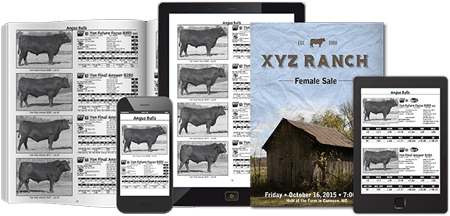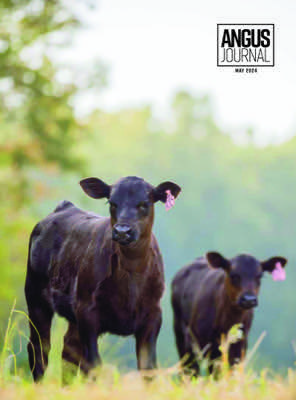Understanding Calving Ease EPDs
By Dan Moser
|
Angus Journal
1/10/2020
Since 2005, the American Angus Association has published EPDs for calving ease direct and calving ease maternal. Prior to that date, only birth weight EPDs were available to improve calving ease in Angus cattle.
Compared with selection on birth weight (BW) expected progeny differences (EPDs), use of calving ease direct (CED) and calving ease maternal (CEM) EPDs offer several advantages. To make the most effective use of these tools, it’s helpful to understand a few relevant details.
Calving ease is scored on a scale from 1 to 5. A score of 1 represents an unassisted calving, 2 is some assistance, 3 is mechanical assistance, 4 is a C-section, and 5 is an abnormal presentation.
In the genetic evaluation, abnormal presentations are removed from the evaluation, because generally calves that come backwards or upside down are not the result of genetics, just random chance. Type of assistance provided may vary across operations. Accordingly, scores of 2, 3 and 4 are combined, so the data in the evaluation considers calves as assisted or unassisted.
While the economically relevant trait to a commercial rancher is whether the calf required assistance or not, birth weight is a highly useful indicator trait.
Birth weight is the most significant factor influencing calving ease. The genetic correlation between calving ease score and birth weight in the Angus genetic evaluation is fairly strong: 0.65. This indicates as birth weight increases, there is a strong tendency for greater calving difficulty, reflected in higher calving ease scores. For this reason, birth weight data is used in the CED and CEM EPD calculations as a correlated trait.
Worth noting is that while breeders are encouraged to report calving ease scores on all calves, only the scores from calves born to first-calf heifers are used in the evaluation.
The incidence of assisted calvings in older Angus females is so low, there would be no benefit to including that data in the evaluation. However, all birth weights are included in the CED and CEM calculations. Accordingly, if a bull is used initially only on mature cows, and the resulting calves are lighter than expected, his CED EPD will increase.
Using CED and CEM
It’s important to understand that while CED and CEM EPDs are expressed in percentage units, they are used the same as other EPDs.
If Sire A has a CED EPD of 8 and Sire B has a CED EPD of 3, you would expect 5 percentage points less calving difficulty when similar heifers raised and calved in similar environments are bred to Sire A versus Sire B.
In a herd with very little calving difficulty, if heifers bred to Sire A require assistance at calving 4% of the time, similar heifers bred to Sire B might require assistance at 9% of calvings.
In a herd with more calving difficulty due to genetics, environment, or both, if heifers bred to Sire A require assistance 12% of the time, you’d expect assistance to be required 17% of the time when the heifers are bred to Sire B.
In any case, differences are additive just like EPDs for growth traits expressed in pounds, not multiplicative.
Most likely one of the most misunderstood values provided in the Angus genetic evaluation is the CEM EPD.
Producers understand how important it is to maintain and improve the ability of females to calve, through increased pelvic area and other factors.
CEM EPDs reflect the total difference in a sire’s daughters’ ability to calve unassisted. Those daughters’ assistance rate is due to both direct and maternal effects. Sires with greater CED transmit half that advantage to their daughters, and that in turn influences the size of the daughters’ calves.
The CEM EPD combines the CED value with the maternal-only effect from the genetic evaluation, using the following equation, CEM EPD = ½ CED EPD + MCE EPD, where MCE EPD is the maternal-only effect on calving ease. So CEM is not a maternal-only calving ease prediction, instead it combines direct and maternal effects to predict the rate of observed calving difficulty in a sire’s daughters.
While the maternal-only value is not printed in beef genetic evaluation results, it can be determined with some simple algebra in a spreadsheet:
MCE EPD = CEM EPD – ½ CED EPD
It might be interesting for Angus breeders who want to emphasize maternal calving ability to look at this value on their artificial insemination (AI) sires. A bull that is exceptionally high for CED can have an average or better CEM EPD, while the true maternal effect his daughters express is rather unfavorable.
The graph (above) shows Angus genetic trends for several calving-related traits over the last 15 years.
On the left axis, average CED and CEM EPD are plotted by birth year, along with the MCE maternal-only effect on calving ease. Average BW EPD by birth year is plotted to the right axis. You can see through selection, Angus breeders have increased CED and decreased BW, but CEM and MCE are largely unchanged. The slight increase in CEM is mostly due to reduction in calf size (CED), not improved maternal ability to calve unassisted.
Occasionally, members ask if selection for higher CED will ultimately result in reduced maternal ability to calve unassisted. In the Angus genetic evaluation, the genetic correlation between direct and maternal (only) calving ease is -0.06, very near zero.
One wouldn’t expect selection on CED to have a significant effect on maternal calving ability. But the benefit of having a calving ease evaluation, as opposed to only birth weight, is that the maternal component of calving ease is part of the evaluation, and can be included in selection.

By the Numbers is a monthly column in the Angus Journal. This column was written for the January 2020 issue. Subscribe here to receive the monthly publication.












